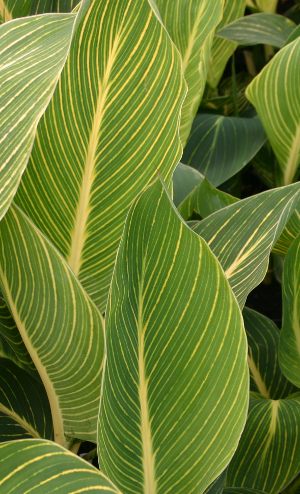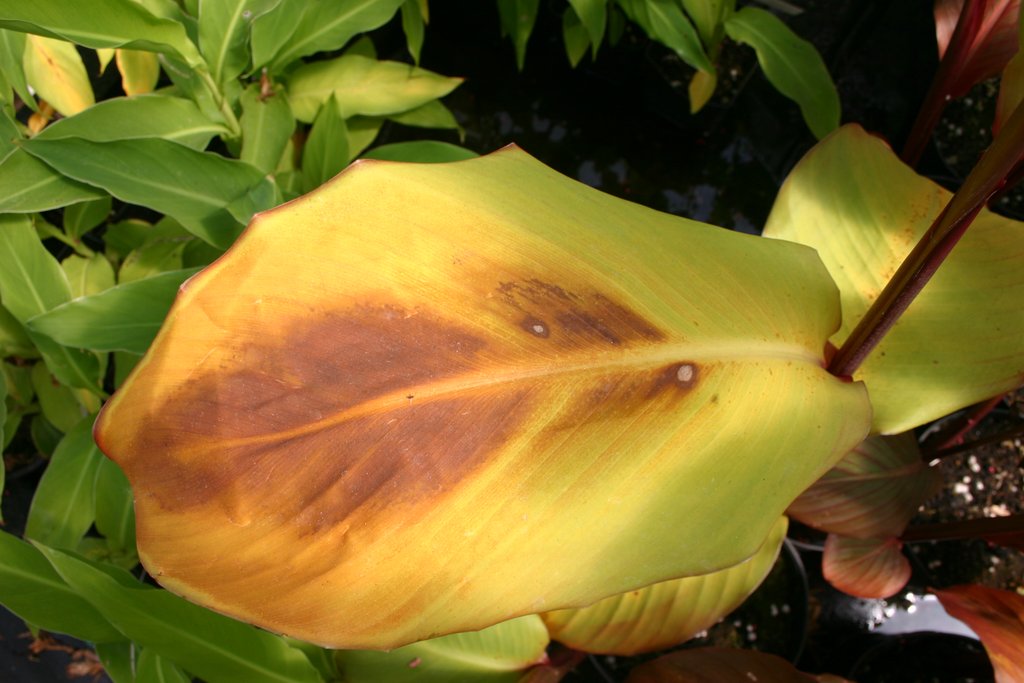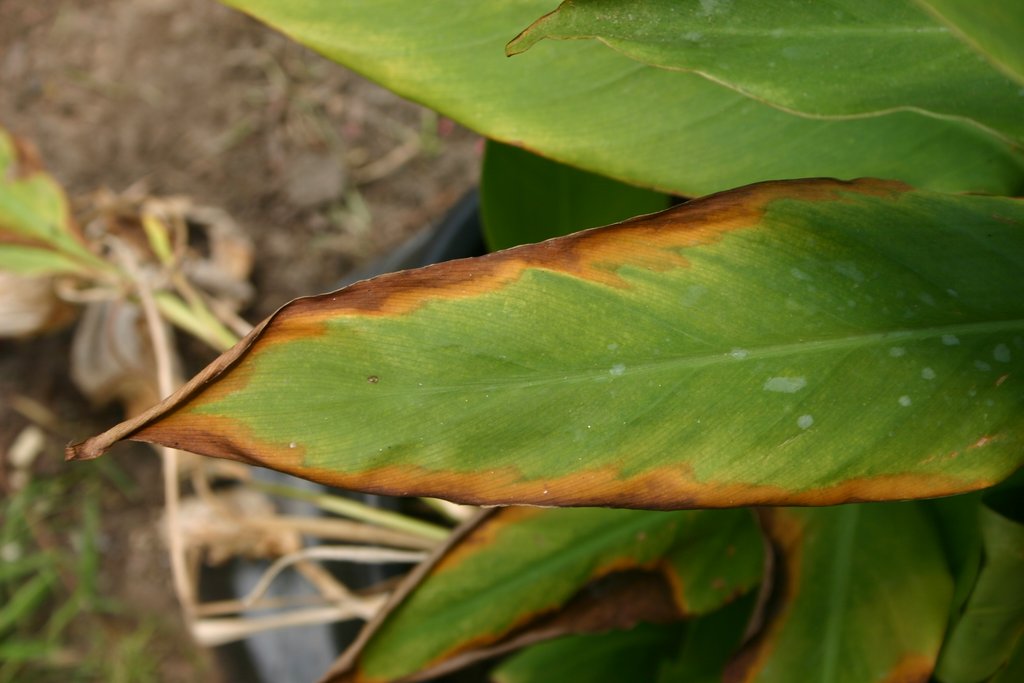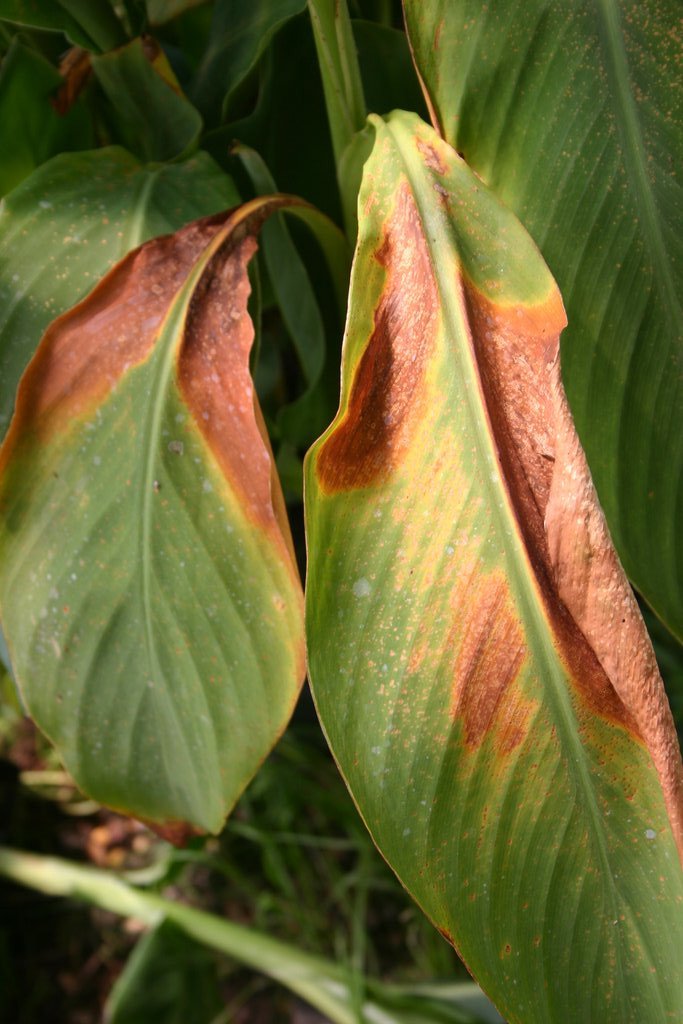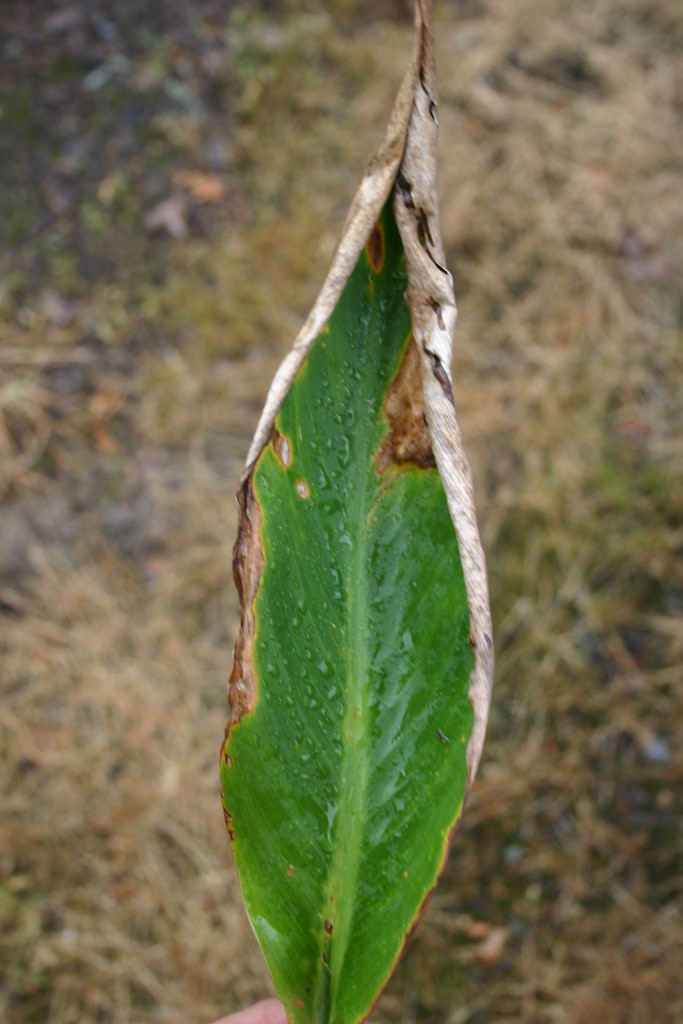|
Canna virus disease was largely unheard of in years gone by. It burst upon the canna world in the early 2000s. Within a few years it infected cannas in many countries, including Europe, the USA, Israel, Australia, and some countries of the far east. Cannas in many gardens, collections and municipal plantings were thoroughly infected. Many cherished collections were decimated, and many old heritage varieties were lost forever. In the author's opinion, its rapid advance was due to established infections in large commercial productions, particularly in the Netherlands, and to the bulk export of these diseased plants to other countries. The photo below shows a field of a hectare or so of canna 'Wyoming' in the Netherlands, thoroughly infested with virus disease. These cannas were destined for export.
Figure: Diseased canna production in Holland (variety 'Wyoming'). Photograph by the author in 1999. 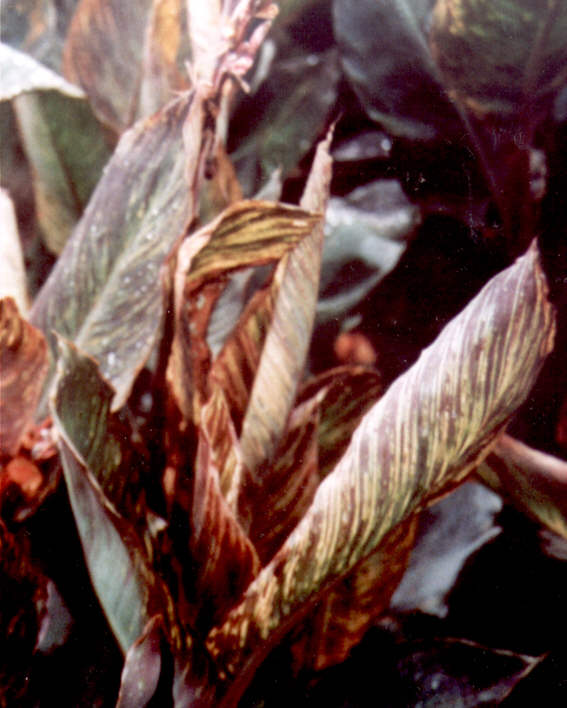
Figure: Close up. One may wonder why this state of affairs was allowed to come about. Surely there are laws which prevent the exporting of diseased plants across national boundaries. The answer is that yes there are such laws, but they do not apply to "ornamentals" such as cannas. When plants, including cannas, are exported they require a certificate of plant health (known as a phytosanitary certificate). The phytosanitary certificate for the import of cannas is only required to show that the cannas do not carry potato disease! If they carry canna disease then that is quite ok, so far as the government of the UK, and other countries, are concerned. It should be assumed that cannas purchased as rhizomes from hardware stores and garden centres will be infected, because they are usually imported. In early 2011 we purchased 40 pre-packed canna rhizomes from hardware stores and garden centres. 38 were infected with virus disease (these included rhizomes purchased from all the big multiples, and also the RHS Wisley Garden Shop). Also in 2011, visits to large garden centres and hardware stores to see growing canna plants showed that many plants being offered for sale were already infected.
Figure: Diseased canna grown from a rhizome purchased in a hardware store, variety 'En Avant'. Plants grown in municipal plantings such as parks and gardens are often infected.
Figure: Diseased canna in a London park, August 2011 However, we are pleased to see that some municpal planters are now taking the problem seriously. They are destroying their diseased stock and replacing it with healthy stock which is sourced from virus-free suppliers. Public gardens that are now free of virus include RBG Kew Gardens in London, and the Hillier Arboratum in Winchester. In spite of the fact that the disease has been prevalent for many years, the import of diseased rhizome and plants continues. The photo below shows diseased cannas in a traffic roundabout near Guildford, England, 2014. This particular photo is interesting in that the leaf on the extreme right appears to be healthy (for the time being). The contrast with the other diseased foliage can be clearly seen. Maybe this council has learned a lesson, because in 2015 the traffic roundabouts are not planted with cannas. Note that the diseased cannas are equally vigorous. Variety 'Durban'
Figure: Diseased canna in a traffic scheme, Surrey, UK, 2014. .Conscientious growers have now eradicated this disease from their stock, but many commercial growers continue to have their entire production infected with this disease and don't seem to care. As there is no law against growing, selling, importing and exporting diseased plants, so they continue to do it. It is a serious problem throughout the continent of Europe, the USA, Israel, the far east, and Australia. Amazingly, the catalogues and sales brochures of commercial growers and traders sometimes clearly illustrate diseased cannas! Some countries, such as South America, Africa, India, seem to be largely and maybe completely free of it, presumably because there is no substantial importing of diseased commercial stock from countries where the disease is rife. Virology There are believed to be 5 viruses which infect cannas. But, according to experiments by the CSL laboratory in York, UK, there is only only one virus which which is causing the present epidemic. This virus has been allocated the name "Canna yellow streak virus" (according to the nomenclature convention, only the 1st word is capitalised), and has the formal designation CaYSV. It was identified and named in 2007 in a scientific paper published in the UK (incidentally, largely from samples provided by the author). It is believed that the virus mutated to cannas from a disease of grass (Johnsongrass virus). It doesn't kill plants but it causes foliage which is disfigured by spots and streaks. Later these streaks turn brown, and the foliage becomes badly distorted with diseased and dead areas. The plants then look very sick, but they continue to grow vigorously, and flower. This virus is unique to cannas. It is spread by aphids. It does not affect other plants, and it can't be spread to cannas by other plants. It is believed to be not transmitted in seeds. According to the author's experience, it is not retained in the soil, even in composted diseased canna foliage. If it was retained in the soil, he would not have been able to grow healthy cannas on the same land where diseased cannas were grown the year before. There is no cure, and diseased cannas should be destroyed. Incidentally, it is sometimes said that the stripes in varieties with striped foliage, such as 'Pretoria' (Syn 'Bengal Tiger'), 'Durban' (syn 'Phasion', 'Tropicanna). This is an incorrect assumption. Canna Virus in Horticulture Often, canna folk are encountered who are quite oblivious of the fact that all their plants are badly diseased, and they don't realise that their plants would look vastly better if they were healthy. On the other hand, some gardeners are paranoid about canna virus, and mistakenly think that any and every blotch or disfigured leaf is an indication of virus. It is important to be scientific about the identification of virus disease. The early symptoms of canna virus are quite specific. What you are looking for are the yellow streaks which give the virus its name (actually, they are pale green, but look yellow against the background of a green leaf). These streaks run along the leaf veins. They are usually about 3mm wide, and pointed at each end. Sometimes a streak is broken in the middle, and then takes on the appearance of 2 wedges back to back. Often the leaf is also quite speckled. The author often looks for these virus lesions on a newly emerging leaf which has yet to fully unroll. Streaks on such virgin leaves are strong evidence of virus. The 3 photos below shows the incontrovertible symptom of early canna virus disease, ie a pale streaks along the leaf veins.
Figure: Early stage virus, pale streaks and speckles but no leaf distortion evident. 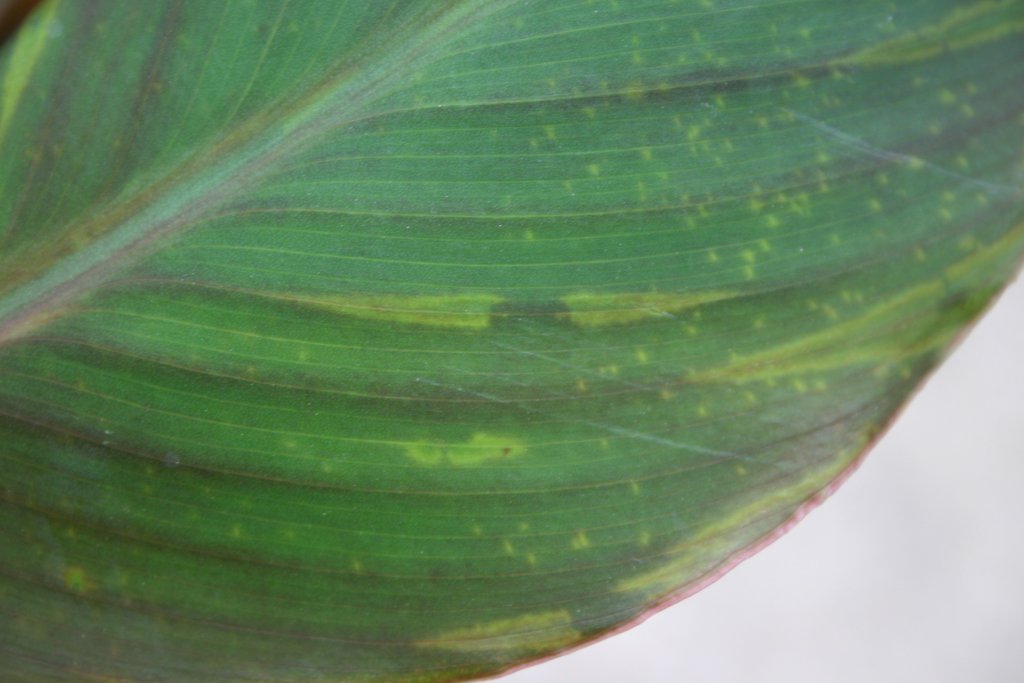
Figure: Early stage virus, showing the characteristic broken streak, which looks like 2 wedges back to back. Canna virus usually is to be seen in the topmost leaves, even onleaves not yet unfurled.
Figure: Virus symptoms on a leaf not yet unfurled. As the disease progresses, leaf distortion and necrosis becomes evident.
Figure: Late stage virus, leaf distortion and necrosis are evident (variety 'Ehemannii')
Figure: Late stage virus
Figure: Late stage virus (variety 'Durban' Syn: 'Phasion', 'Tropicanna') Sometimes the characteristic streaks of virus are also evident in the flowers. Figure: Virus streaks in a flower (variety 'Panache'), shown alongside healthy flower. Figure: Virus streaks in a flower (variety 'Delaware'). This disease is spread by aphids (though aphids are rarely seen on cannas). Although it does not spread very quickly through a collection, its spread is relentless. There is no cure and infected plants should be destroyed. The virus is not carried in the soil, or in seed. It seems that all canna garden varieties, and maybe all species, are vulnerable to virus disease. It doesn't seem to infect any plants except cannas, or to be transmitted to cannas except from other cannas. To avoid virus needs care to acquire cannas only from a trusted source, to keep them well separated from existing cannas, and to watch growing plants and cull any that show symptoms. Canna virus is here to stay. It will crop up from time to time. Identification of virus in specific varieties The disease is readily identified in green leaf varieties. In some bronze leaf varieties it can be difficult to conclusively identify, particularly in 'General Eisenhower'. On the other hand, in 'Australia', which also has a very dark leaf, it appears as bright yellow stripes against a chocolate background. It is very easy to see in the variegated variety 'Durban' (syn Tropicanna, Phasion), where the pink stripes in the leaf become broken and change to yellow or green. On the other hand it is often most difficult to identify in the variegated variety 'Pretoria' (syn 'Bengal Tiger') where the leaves seem to take on a "sandy" appearance. Some photos are given below.
Virus in typical bronze leaf variety, streaks & speckles, compared with a healthy leaf.
Virus in 'Australia'. Yellow streaks
Virus in 'Durban' (syn, Tropicanna, Phasion). Pink stripes replaced by green. Virus on left, healthy leaf on right.
Virus in Pretoria, which is not so easy to see as in other varieties. Diseased on left, healthy on right. Canna symptons that are not virus Some gardeners are paranoid about canna virus. They think that every and any leaf blemish may be virus. The following photos show leaf blemishes and symptoms that are not virus. Particular conditions that are oftem confused with virus are: Brown or pale areas of leaf. Usually caused by lack of water and excessive sun radiation and lack of nutrient. Dry and browned leaves: can be due to Red Spider Mite. Brown speckles in stressed plants: Canna Rust
Figure: Not virus
Figure: Not virus
Figure: Not virus
Figure: Not virus |
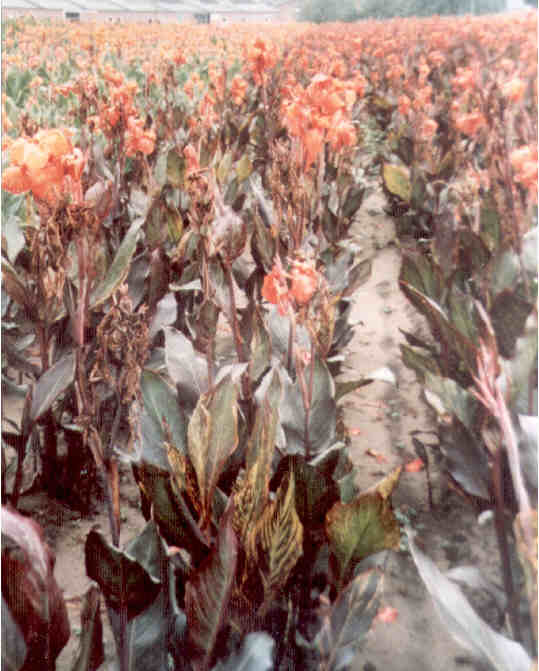
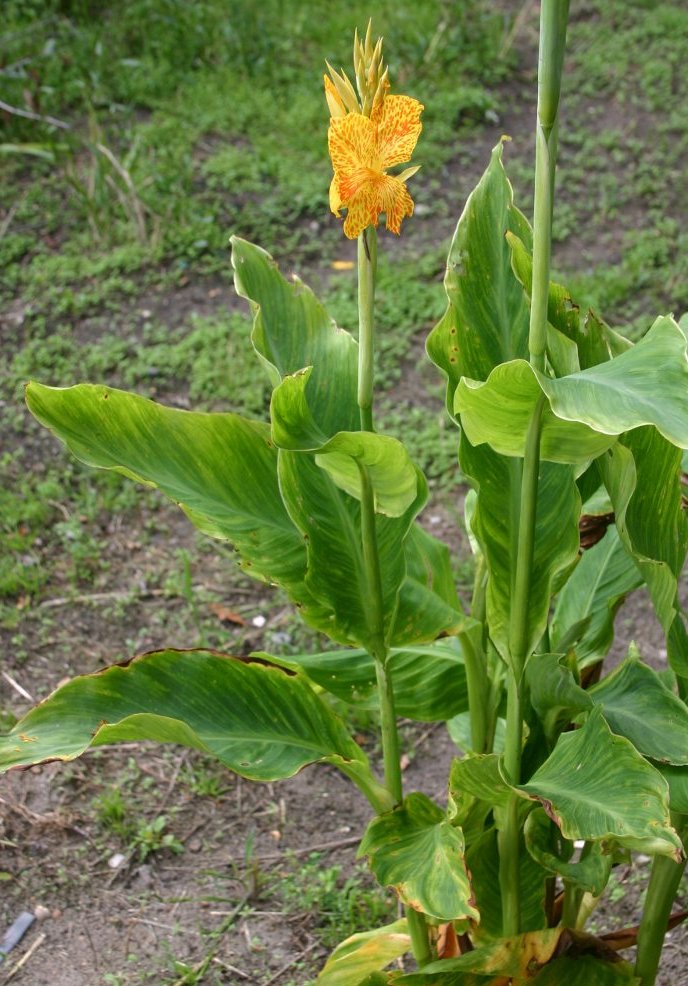
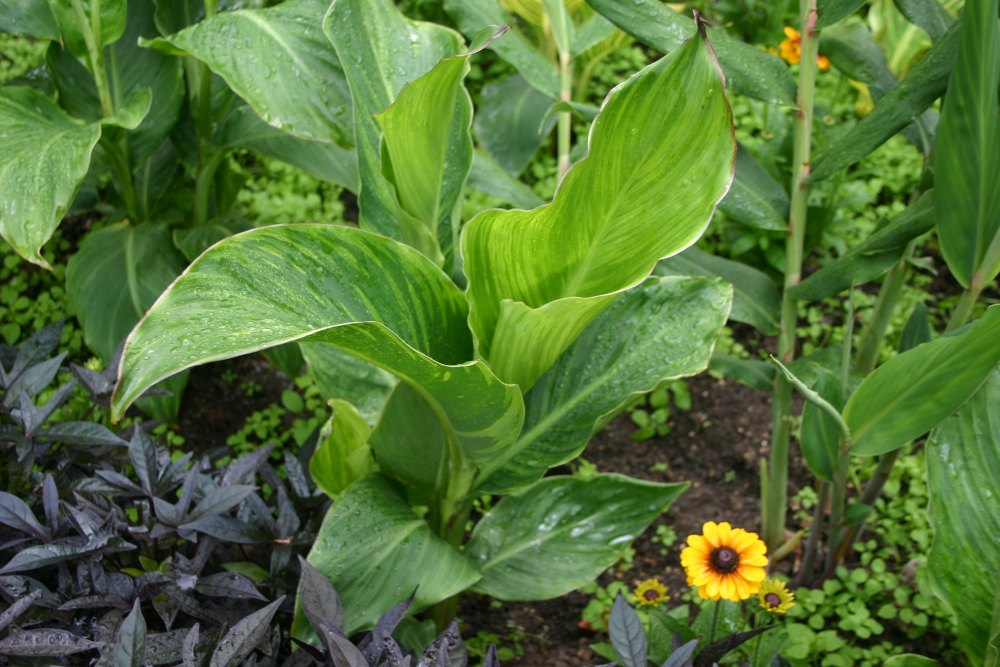
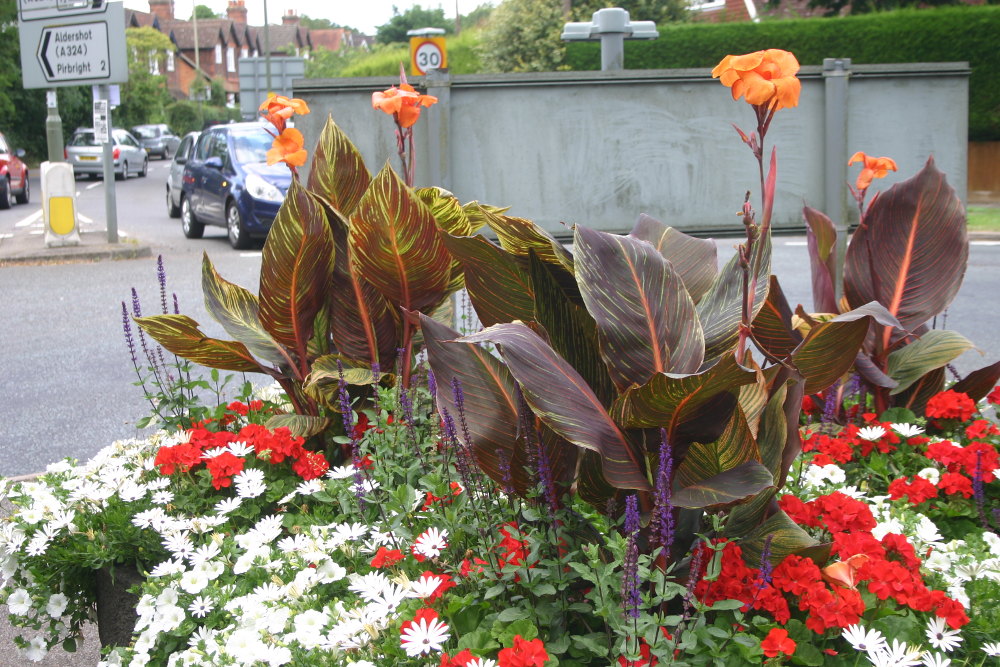
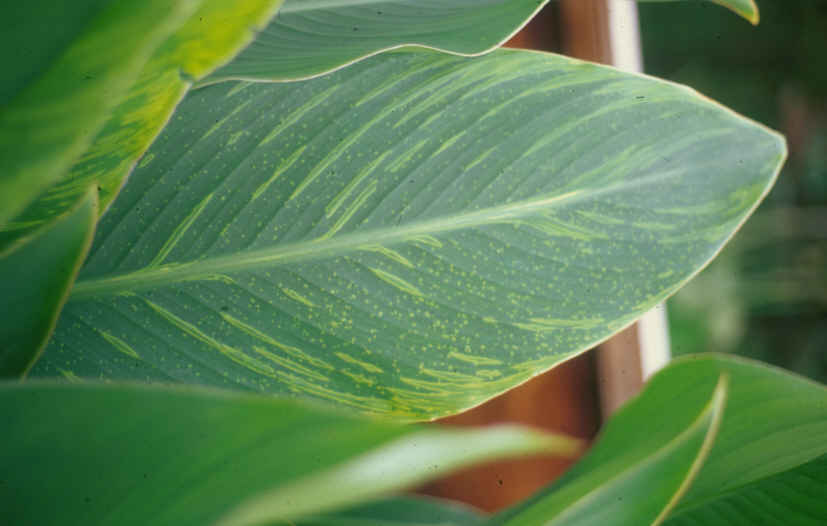
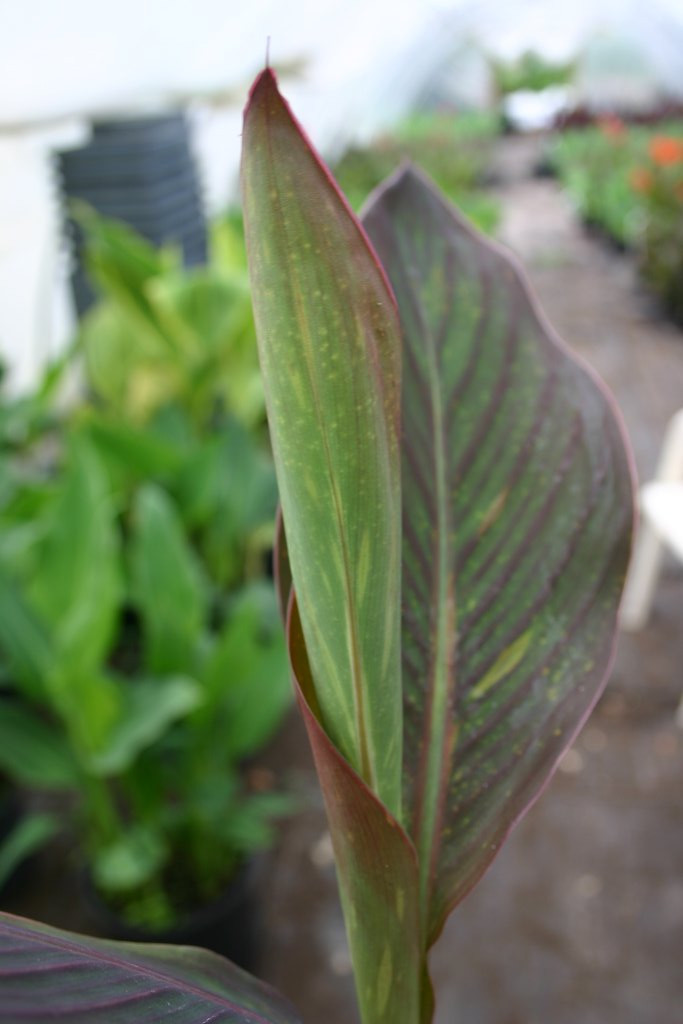
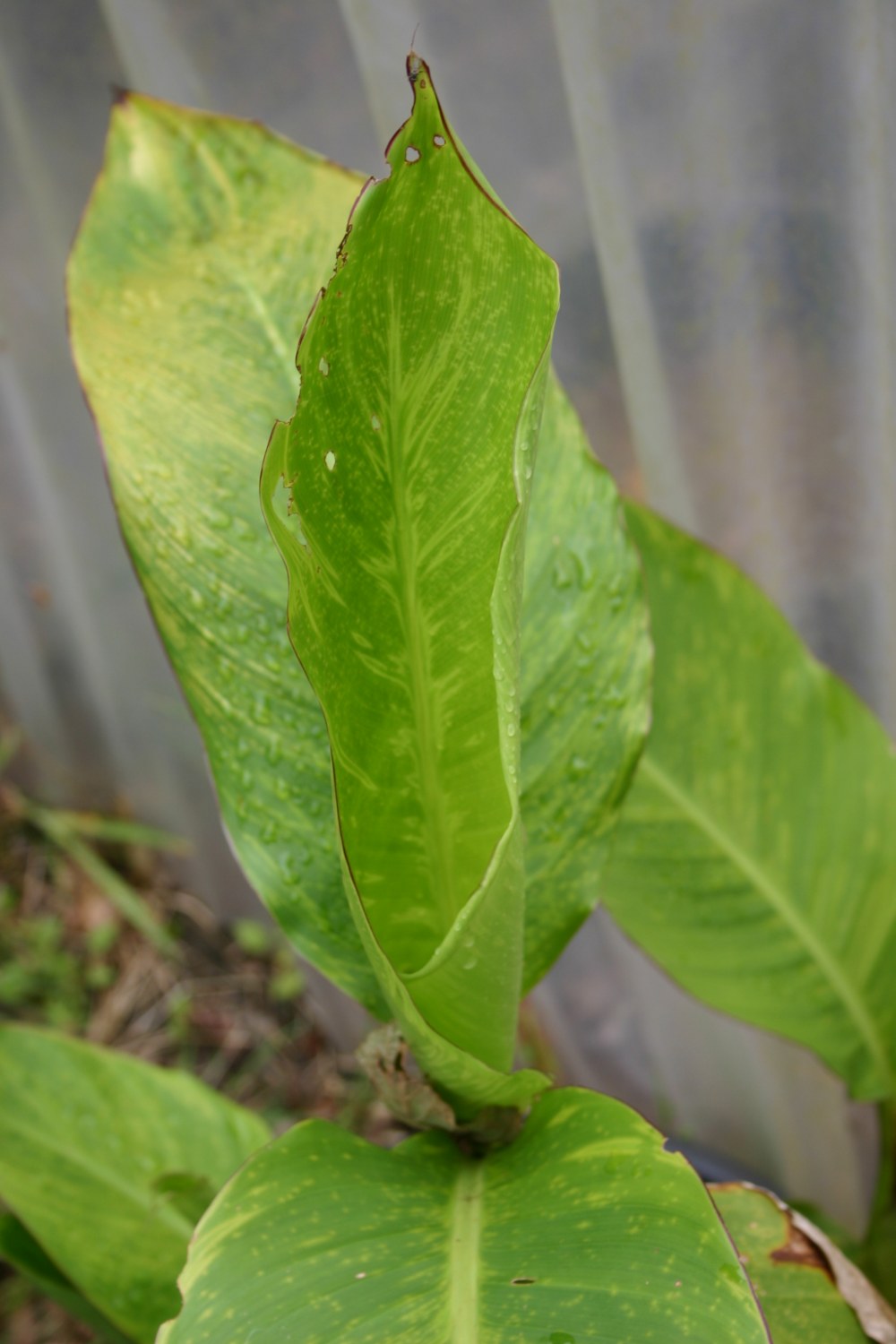
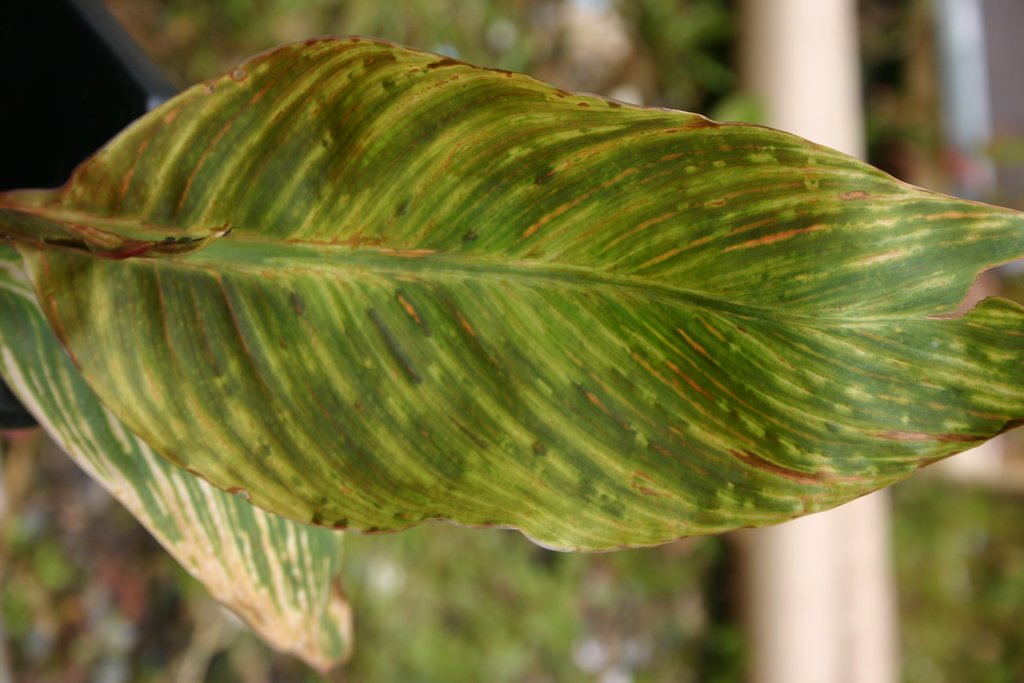
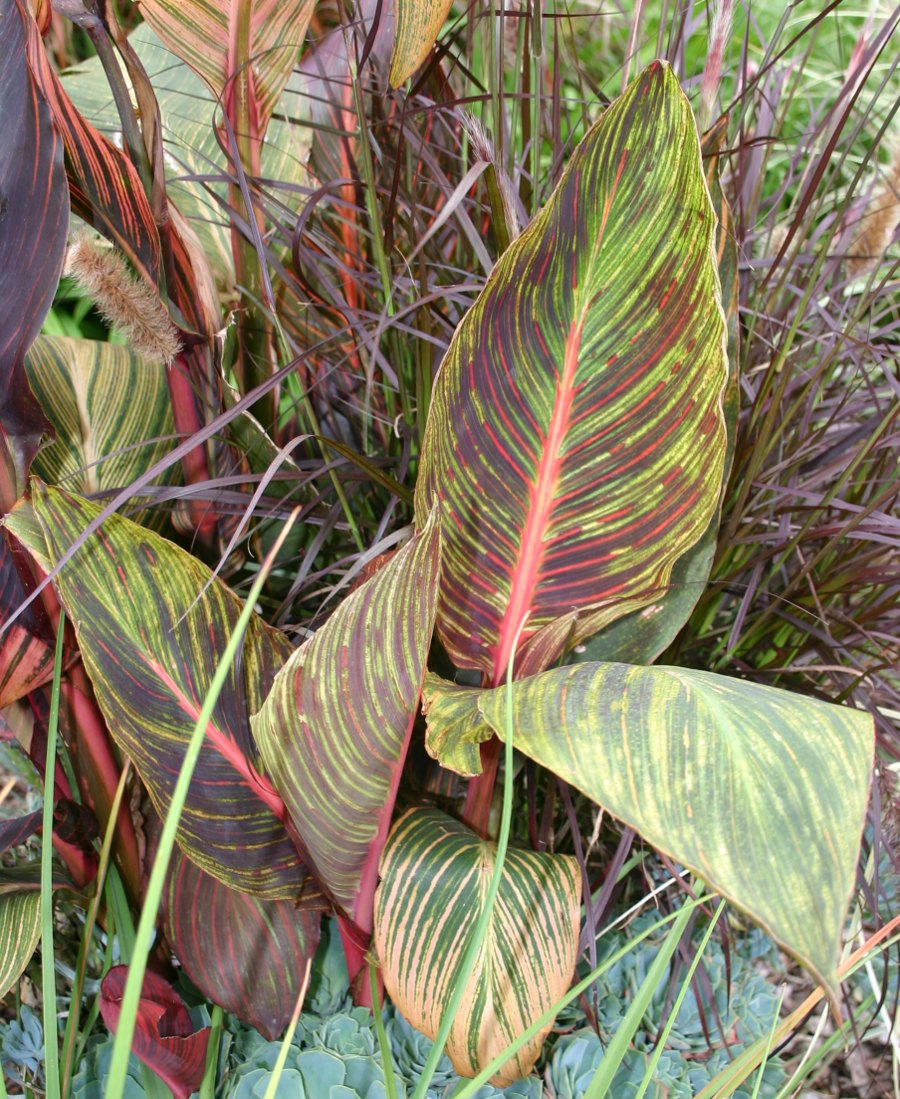
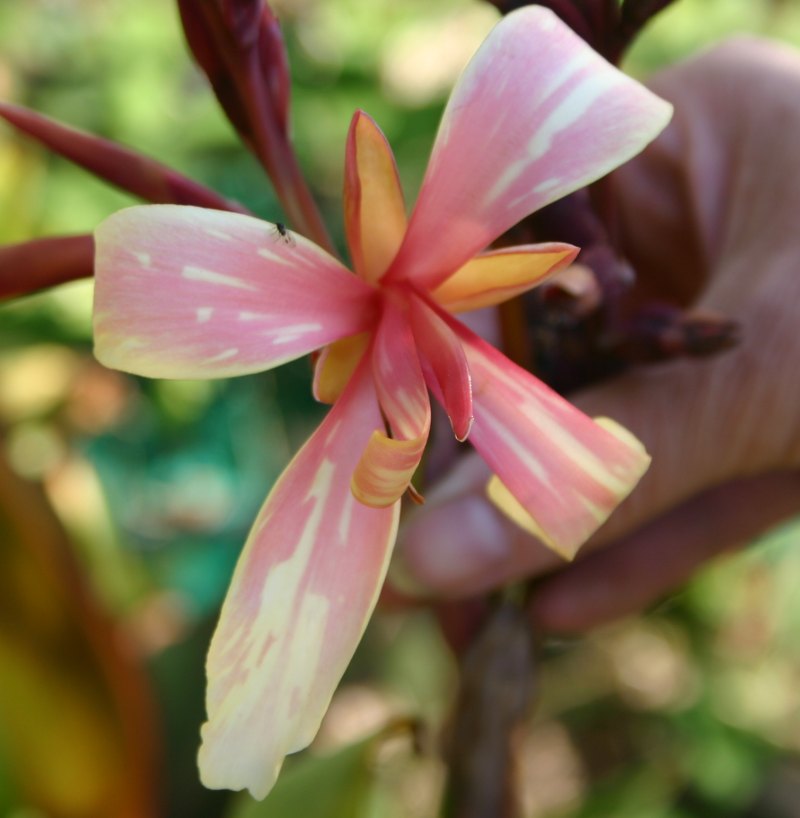
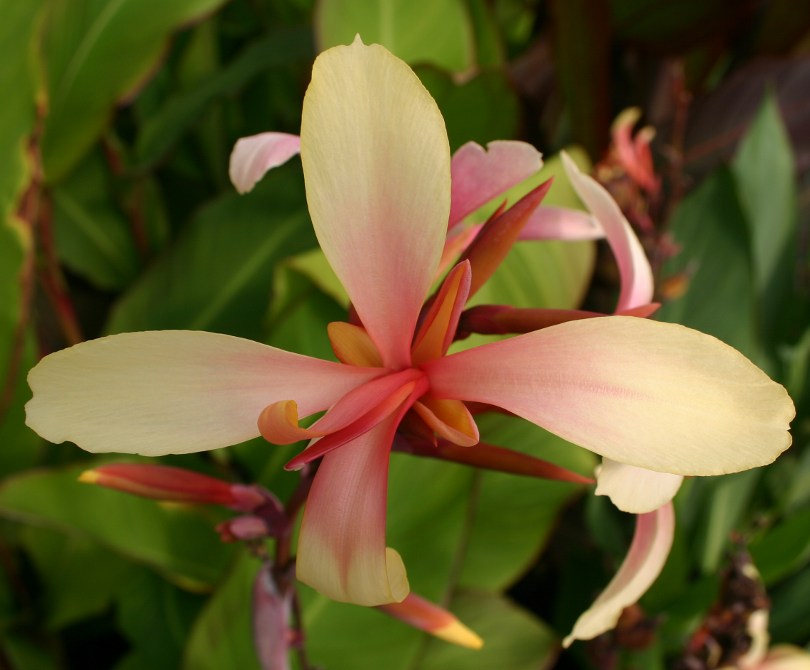
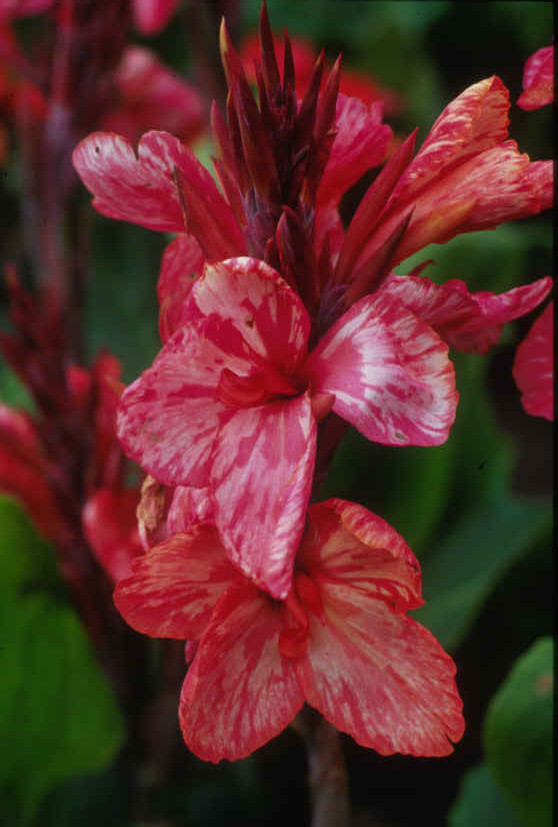
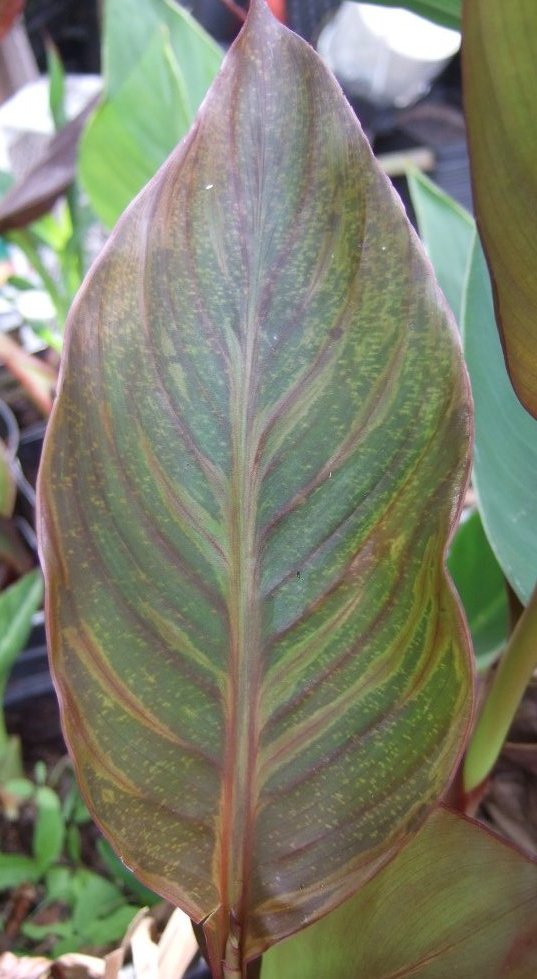 -
- 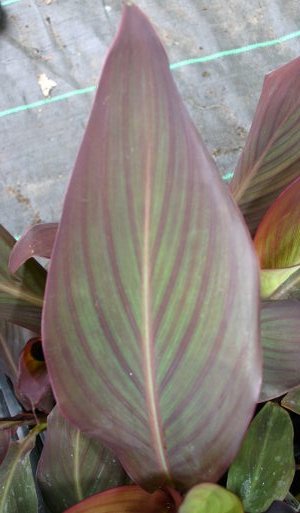
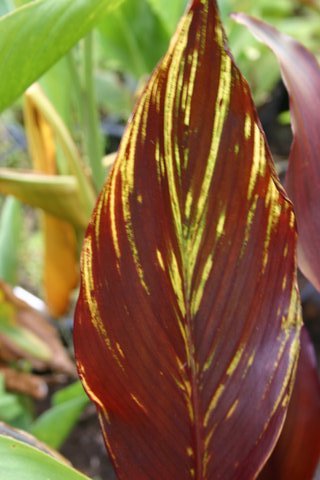 -
- 
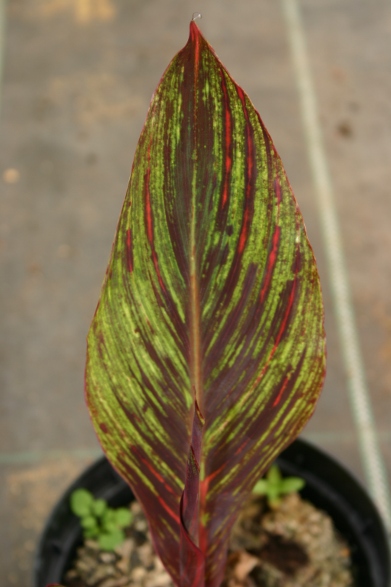 -
- 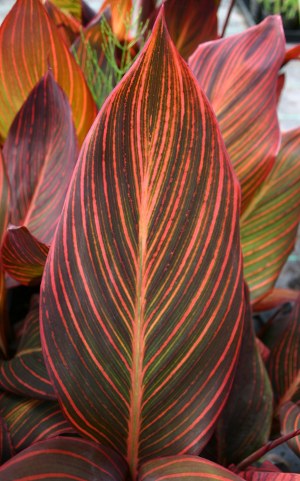
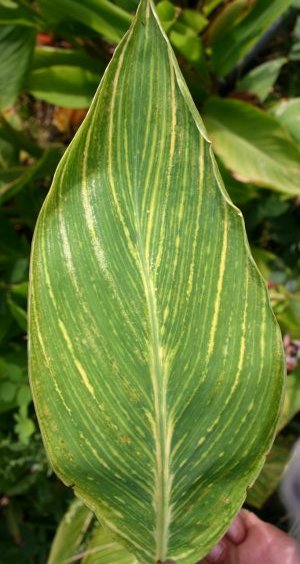 -
- 